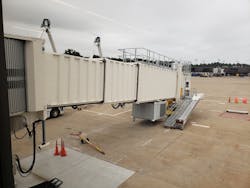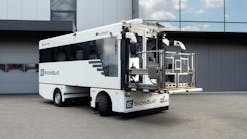Boarding Bridges the Holistic Way
Holism, the idea that individual parts of a system should be viewed in conjunction with the whole, may not be the philosophy that springs to mind when thinking of boarding bridge replacements – but maybe it should.
Norfolk International Airport (ORF) undertook a 17 boarding bridge replacement project with a holistic approach – saving them time and money – and allowing them to add on another bridge to the project for a final total of 18.
The project was lead by AERO BridgeWorks, Inc, who coordinated and managed multiple layers of subcontractors and equipment manufacturers, including a combination of ground support equipment providers.
“We wanted a holistic approach that would really streamline everything for the project and take some of the coordination of going back and forth between the manufacturer and the general contractor out of the picture and let them talk directly since they’re contracted together,” said Jeffrey Bass, director of facilities, Norfolk Airport Authority.
Bass said that they were able to cut out a significant amount of time from the project. Originally, ORF scheduled the project to take about 950 days and they finished six months ahead of schedule.
“We were six months ahead of schedule on the project because of the way that we did the approach with letting the general contractor push with the manufacturer to get the passenger loading bridges here faster. And then they coordinated all the equipment that needed to be onsite during the installation. The contract also allowed them to pick and choose who the manufacturer was on particular equipment that’s associated with a passenger loading bridge based on the specifications. This approach saved over $2 million on the project,” Bass said.
“The original project was 17 gates,” added Jason Pearson, vice president at AERO BridgeWorks. “We were able to deliver the project under their budget and over six months ahead of schedule. The cost and time savings allowed the airport to replace an additional gate.”
Bass said altogether, the final cost of the project came to $17.8 million not including consultant fees.
Kraig Taylor, site superintendent with AERO BridgeWorks, said that ORF opting to include not just the bridge equipment, but also all the foundations, site/civil, building infrastructure upgrades and terminal exterior modifications in a single contract ensured the entire project was fully coordinated. This approach significantly reduced the airport’s risk and was key to the overall project success.
“Norfolk included all of the infrastructure related to the bridge in one package and this decision was paramount in our ability to ensure the project was well coordinated, completed safely and with the highest level of quality. When it’s all under one contract, then there’s one point of responsibility and it’s much simpler for the owner to coordinate it and much easier for us, quite honestly, to do our job and work with all of the stakeholders,” Taylor said.
New Bridges, New Tech
The driving forces behind the project were the age of the existing bridges, some dating back to the 1980s, and ORF’s wish to bring the maintenance of the bridges under their control.
“We had a lot of different jet bridges made by different manufacturers, being maintained by different groups. And the consistency was just not there, and the level of quality of being maintained was not there for it,” Bass recounted. “We changed our program here at the airport to include the maintenance of all jet bridges so that the airport would then own, operate and maintain the jet bridges for all of our airline tenants. The ultimate goal was to basically create a better experience for our passengers, cleaner jet bridges, well-maintained, and just a better appearance overall. And that was something that in the past we’ve had problems with leaking jet bridges, and rusty jet bridges.”
Bass added while the airlines are great at maintaining planes and moving passengers, airlines have limited staff at a small hub making it difficult to maintain a piece of equipment like a jetbridge.
“And so, we changed our approach to be more holistic from the airport’s perspective. Because we’re good at maintaining facilities, and we’re good at keeping an appearance that we want to set for the overall airport. And I think that this was an opportunity both for the airlines to relinquish some of their responsibilities and focus in on their business models, and for us to focus in on what’s kind of our core responsibilities, too,” he continued.
The upgrade to new bridges also gave ORF greater technology than their 1980s equipment.
“When you compare 1980s era equipment to current equipment, there are significant upgrades and technologies,” said Pearson. “New features include safety upgrades such as cameras for increased visibility around the boarding bridge during operation, a bumper surrounding the wheels to immediately stop the bridges if it comes in contact with anything on the ramp, and other technologies such as HMI screens instead of traditional buttons and dials providing a better human/machine interface. This results in a more efficient and safer boarding and deplaning process which improves the efficiency of the airport and airlines operating there.”
One of the newest features of the bridges at ORF is a monitoring system called iOPS. This system provides real time data to the airport on the current status of equipment and can provide preventative maintenance notifications.
“They receive real time data from the iOPs system on how each piece of equipment is operating, for example, what temperature the air conditioner is blowing and the status of each piece of equipment. If something goes down, the airport receives an immediate notification instead of waiting for personnel to identify an issue. This minimizes any downtime and increases the efficiency of operations and overall customer experience” said Pearson.
“The remote monitoring system allows us to have our finger on the pulse and help our ultimate goal of reduced flight delays that might be caused by equipment failures,” added Bass.
Uniquely, ORF requested six CCTV cameras strategically installed throughout each of the passenger boarding bridges, said Nicholas Monaco, AERO BridgeWorks project engineer.
“Typically there’s one, maybe two cameras on the bridge itself to monitor activity in the area, but Norfolk requested that we have six cameras with the capability to be recorded for up to ten days at a secure location. This way, Norfolk personnel are always aware of what was going on around the exterior and interior of bridge” he said.
As part of the technology upgrade, an all-new fiber communication backbone and upgraded electrical systems were installed. “There were two concourses at the airport and we ran fiber throughout both concourses to have connection points at every single gate” said Monaco.
The technology upgrade required an all-new fiber communication backbone and electrical system.
“It was a huge fiber communication upgrade,” Monaco said. “There were two concourses at the airport and they ran fiber throughout both concourses to reach out to every single gate.”
To keep the project on track while diminishing its impact on ORF’s operations, the airport and AERO BridgeWorks created a tight, phased schedule to bring the bridges online. The year before the project, Bass said ORF worked with IT provider Amadeus to install a network system that would go to all of their common use gates.
“We created a schedule in which we would only take down one passenger loading bridge at a time from a particular airline, and then be able to move them to a common use gate temporarily for the duration of construction for that particular gate,” said Bass. “So, at any point in time, I would have down only about two to three passenger loading bridges at a time at the airport, but we would break it up as I would take one from each airline during that duration or for how many airlines that I would need it at that point on the schedule. Because we broke it into about seven phases of the project.”
“The project was executed at a fully operational airport and required the team to plan essentially seven phases,” added Taylor. “Working with ORF Operations, the lead architect and an owner’s representative, AERO developed a plan which initially installed three gates at locations which, at the time, were not serving specific airline tenants. Those gates then operated as swing gates for future phases. AERO and the Owner’s Representative worked closely with the airline tenants and with the airport authority to expedite phasing the airline gate movement. This often provided the opportunity to shave additional time off the project schedule.”
Monaco said the team executed a two to three week turn per gate, with the start date at each gate offset by one week. Once the project was underway, they were taking a gate out of service and putting a different gate back in service each week.
“We had to phase the work. Multiple activities and crews were closely coordinated and worked together including electricians, civil contractors, ramp striping crews, cranes and of course the bridge and equipment all within one gate area. In this approach, we were able to perform all the work at the gate without impacting any adjacent operations, which was much appreciated by the airport and how we normally perform our installations,” Pearson said.
The Benefits of Holism
With only some finalizing left to be done for the iOPS system, ORF is reaping the rewards of their holistic approach to the project. Bass said it’s been a major benefit from a maintenance perspective.
“Because I can purchase spare parts, and they work on every single one of the bridges, I don’t have to keep as many spare parts because I don’t have a variety. And it really reduces on my overall costs for keeping stock,” he said.
“And my maintenance costs, because they’re not unique, each one is a repeat of each other, I only have to train my staff on one particular type of passenger loading bridge, and then they can basically work on any of them,” Bass continued. “And so, now I’m able to take over a lot of maintenance items that usually you had to have a significant amount of knowledge since each manufacturer is a little bit different in how they construct and how they wire up their particular passenger loading bridges. This is not the case for us now. So, when they’re trained, they can basically work on majority of our passenger loading bridges, which has been a big cost savings to the airport.”
Aside from ORF saving time and saving money, which allowed them to add another bridge to the project, the holistic approach also proved beneficial on the construction side.
“They didn’t procure just boarding bridges and issue separate contracts for other scopes of this project. Norfolk Airport made this an all-inclusive turn-key project that, in addition to the PBB equipment itself, included all the necessary foundations, electrical upgrades, low voltage improvements, plumbing work, access control, fire alarm connections, ramp striping and exterior building improvements to complete the entire scope of a gate replacement,” said Pearson. “This streamlined the entire process for the airport, resulting in a well-coordinated project completed ahead of schedule and within budget.
“Getting through that turn-key delivery decision process, making sure the design is correct, and then issuing a single package was a great decision by ORF and one we would suggest for any airport considering a passenger boarding bridge replacement program.”






